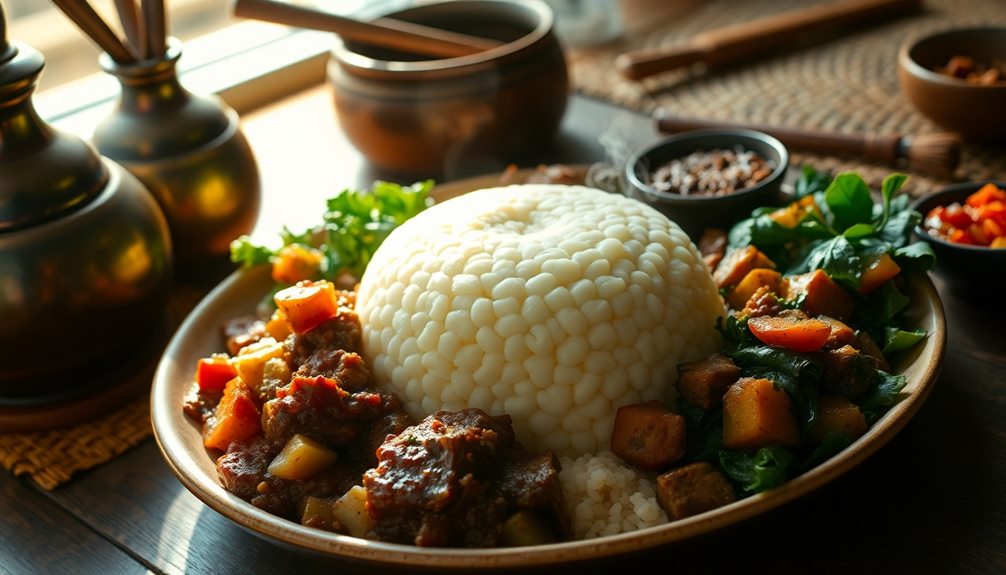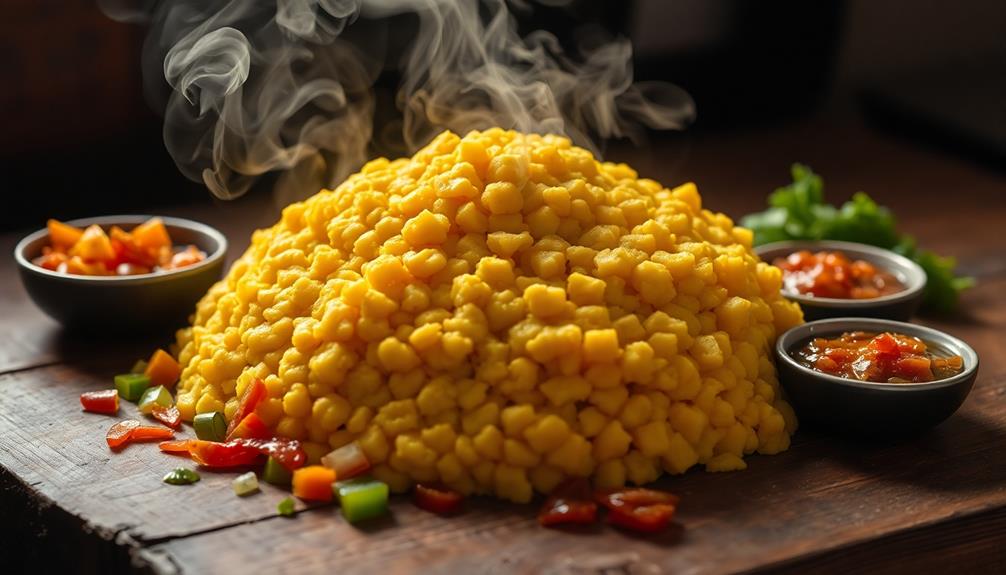Sadza is Zimbabwe's beloved cornmeal porridge, and it's much more than just food! It acts as a warm hug at family gatherings, making every meal feel special. This versatile dish is easy to prepare, needing just maize meal and water. You'll mix, stir, and simmer until it's thick and creamy. Traditionally, sadza is enjoyed with tasty sides like greens or stews, bringing everyone together. It's a symbol of love and unity, showcasing the rich culture of Zimbabwe. You'll discover how sadza connects families and communities through shared experiences, inviting everyone to join in the celebration!
Key Takeaways
- Sadza is a traditional Zimbabwean dish made from cornmeal, serving as a staple food rich in carbohydrates.
- It is often enjoyed with various sides, including leafy greens, stews, and grilled meats, highlighting its versatility.
- The dish has significant cultural importance, symbolizing unity and communal bonding during gatherings and celebrations.
- Sadza is gluten-free and low in fat, making it a healthy dietary option suitable for diverse nutritional needs.
- Its historical roots reflect Zimbabwe's agricultural practices and local ingredients, evolving from ancient indigenous cooking methods.
History
Historically, sadza has been a cornerstone of Zimbabwean cuisine for centuries. This beloved dish, made from ground cornmeal, has nourished families and brought people together at the dinner table.
Imagine sitting down with your loved ones, sharing stories over a steaming bowl of sadza. It's more than just food; it's a part of Zimbabwe's heart and soul.
Sadza has roots that trace back to ancient times. Originally, it was made from various grains, but over time, corn became the main ingredient. As different tribes settled in Zimbabwe, they adapted the dish to fit their tastes and traditions.
This adaptability has made sadza a symbol of unity among diverse communities.
You might be surprised to learn that sadza is often served with delicious stews or leafy greens, making each meal a flavorful experience. It's not just a staple; it's a way of life!
When you enjoy sadza, you're tasting history and culture in every bite. So, the next time you see this dish, remember that you're partaking in a tradition that's been cherished for generations.
Isn't that exciting?
Cooking Steps
To cook sadza perfectly, you'll want to start by gathering your ingredients and tools. You'll need maize meal, water, and a pot. Once you have everything, measure about two cups of maize meal and set it aside.
Next, fill a pot with four cups of water and place it on the stove over medium heat. Bring the water to a boil, and once it's bubbling, it's time to add the maize meal. Stir in the maize meal gradually, using a whisk or wooden spoon to prevent lumps. Keep stirring until it thickens; this usually takes about five minutes.
Now, lower the heat and let it cook for another 10 to 15 minutes. Remember to stir occasionally to keep it from sticking. When it's done, it should have a smooth, thick consistency.
To serve, shape the sadza into small balls or mounds on a plate. You can enjoy it with your favorite stew, vegetables, or meat.
Don't forget to share it with family and friends! Cooking sadza is a fun way to bring everyone together around the table. Enjoy your delicious creation!
Step 1. Measure Cornmeal Accurately

Measuring cornmeal accurately is crucial for achieving the perfect texture in your sadza. If you don't measure right, your sadza might end up too thick or too runny, and that's not what we want!
Start by gathering your tools: a measuring cup and a spoon. It's best to use a dry measuring cup for cornmeal.
First, take your measuring cup and scoop the cornmeal directly from the bag or container. Don't pack it down; just let it fill naturally. Then, use the back of a knife or a straight edge to level off the top. This way, you won't end up with too much cornmeal. If you need a specific amount, like one cup, stick to that measurement.
If you're making a larger batch, just multiply your measurements. For example, if you need three cups, measure each cup separately to keep it accurate.
Step 2. Add Water Gradually

Now that you've measured your cornmeal accurately, it's time to add water gradually. This step is super important because it helps to create the perfect texture for your sadza.
Start by pouring a small amount of water into the pot with the cornmeal. You don't want to dump it all in at once! Adding water slowly lets you control the thickness and makes mixing easier.
As you pour, make sure to stir the cornmeal gently with a spoon or whisk. This helps to break up any clumps and ensures the cornmeal absorbs the water evenly.
Keep adding water in small increments, mixing well after each addition. You want to aim for a smooth, creamy consistency. If it gets too thick, don't be afraid to add a little more water.
It's like making a delicious science experiment in your kitchen! The goal is to get the right balance, so don't rush this part.
Take your time, enjoy the process, and soon you'll see your sadza transforming into a lovely, thick porridge that's perfect for serving with your favorite stew or sauce!
Step 3. Stir Constantly to Prevent Clumps

As you begin cooking the sadza, stirring constantly is crucial to prevent clumps from forming. Imagine the smooth, creamy texture you want in your dish! If you don't stir enough, those pesky clumps can sneak in, making your sadza less enjoyable.
Start by using a sturdy wooden spoon or a whisk. As you pour in the cornmeal mixture, keep that spoon moving! It's like dancing with your ingredients. Move in circles, then switch to figure-eights. This keeps everything combined and happy.
Make sure you're stirring from the bottom, too! This way, you'll catch any parts that might want to stick. If you're cooking with a friend or family member, take turns stirring! It makes the process more fun and less tiring.
Don't worry if it feels a little hard at first; just keep that spoon moving! You're doing great, and soon you'll see your sadza coming together beautifully. The smell will fill the kitchen, and you'll be excited for the next step.
Step 4. Simmer Until Thickened

With the cornmeal mixture well stirred, it's time to let it simmer until thickened. This step is super important, so don't rush it! You'll want to lower the heat to a gentle simmer.
As it cooks, keep an eye on it and stir occasionally. This helps prevent any sticking at the bottom of the pot. You might notice the mixture bubbling softly, and that's a good sign!
After about 15 to 20 minutes, the sadza will start to change. It'll become thicker and smoother, which is exactly what you want. If it looks too thick, you can add a little water, but be careful not to make it too runny.
As it simmers, take a moment to enjoy the delicious aroma filling your kitchen. This is the perfect time to gather your family around, so everyone can get excited about the tasty meal ahead!
Once the sadza reaches the right consistency, you'll know it's almost ready to serve. So, keep stirring and smiling, because soon you'll be enjoying this wonderful Zimbabwean staple that brings everyone together!
Step 5. Serve With Traditional Sides

To truly appreciate sadza, pair it with traditional sides that enhance its flavors and create a well-rounded meal. One of the most common sides is leafy greens, like rape or collard greens, which are often sautéed with onions and tomatoes.
These greens add a delicious, earthy taste that balances the softness of the sadza.
You might also want to try serving sadza with a tasty stew, like beef or chicken, cooked with spices and vegetables. The savory juices from the stew mix perfectly with the sadza, creating a delightful bite that warms your soul.
Another fun option is to add a side of beans, which are packed with protein and flavor. They not only complement sadza but also make your meal even more filling.
Don't forget about local favorites like fried fish or grilled meats, which can add a crispy texture to your plate.
Final Thoughts
Reflecting on the significance of sadza in Zimbabwean culture reveals its deep-rooted importance as more than just a meal.
It's a symbol of unity, love, and tradition that brings families and friends together. When you enjoy sadza, you're not just tasting cornmeal porridge; you're experiencing a piece of Zimbabwean heritage.
Imagine sitting around a table, sharing stories and laughter, all while enjoying this delicious dish. Sadza is often served with tasty sides, making every meal an adventure for your taste buds.
It's easy to see why it holds a special place in the hearts of many Zimbabweans.
Whether you're trying it for the first time or you've enjoyed it many times, sadza connects you with a rich history and culture. It reminds you of the importance of coming together to celebrate life's moments, big or small.
So, the next time you savor this wonderful dish, remember that you're part of something much bigger. You're taking part in a tradition that's been cherished for generations.
Embrace the flavors and the stories behind sadza, and let it inspire you to create your own delicious memories.
Frequently Asked Questions
What Are Common Side Dishes Served With Sadza?
When enjoying sadza, you'll often find side dishes like beef stew, vegetable relishes, or chicken, enhancing the meal's flavor. Don't forget to try the traditional greens for a wholesome, balanced experience!
Can Sadza Be Made Gluten-Free?
Yes, you can make sadza gluten-free by using cornmeal or maize flour. Just ensure the ingredients are free from gluten contamination. This way, you'll enjoy a delicious, safe dish suitable for gluten-sensitive diets.
What Nutritional Benefits Does Sadza Provide?
Sadza offers essential carbohydrates, providing energy for your daily activities. It's low in fat and can be a good source of fiber, helping with digestion. Plus, it's usually paired with protein-rich dishes for balanced nutrition.
How Is Sadza Traditionally Consumed in Zimbabwe?
In Zimbabwe, you typically enjoy sadza with various relishes like vegetables, meat, or sauces. It's often served at family meals, bringing people together. You might also eat it with your hands for a more authentic experience.
Are There Different Regional Variations of Sadza?
Yes, there're different regional variations of sadza. You'll find unique textures and flavors depending on the region, influenced by local ingredients and cooking methods. Each variation reflects the area's culinary traditions and preferences.








